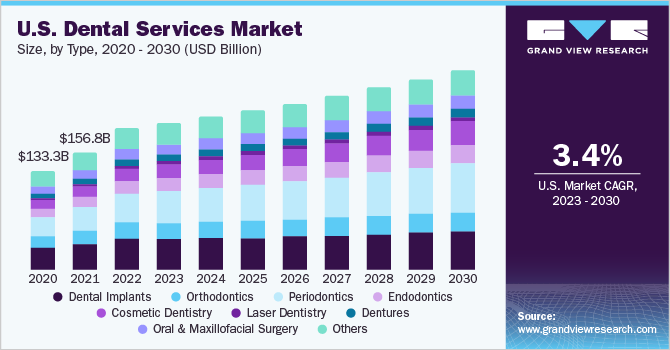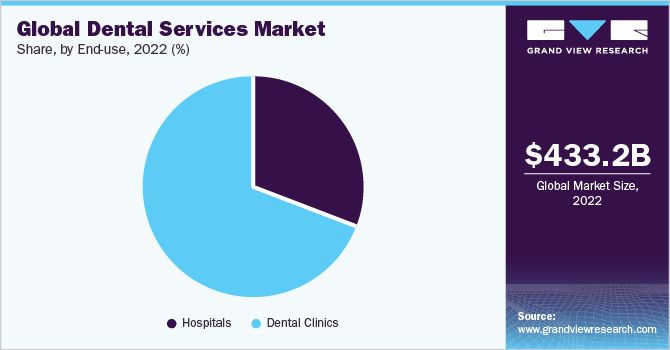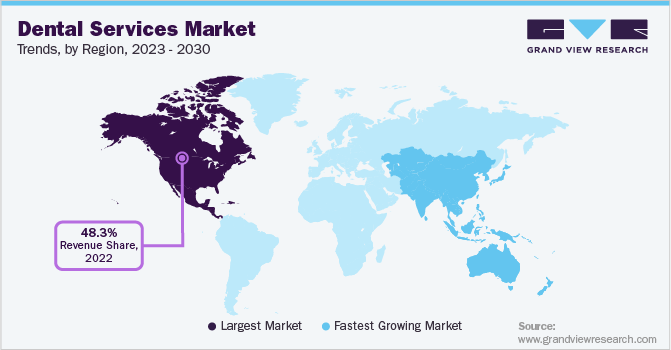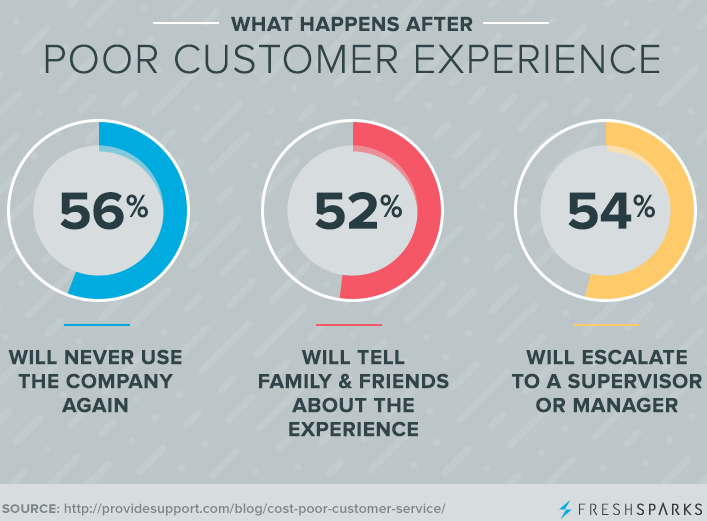The dental service market size was valued at around $34 billion in 2022. With consistent growth and demand for preventative and cosmetic dentistry, opening a dental practice can be an appealing business venture. You’ll need to get the necessary licensing, choose a location, secure equipment, hire quality staff, and market your new practice.

From writing an airtight business plan to attracting new patients, this guide will explain how to start a dental practice. The initial financial investment to lease a space and purchase equipment is considerable, but profitable margins can be maintained long-term by emphasizing high-quality care and patient satisfaction.
1. Conduct Dental Practice Market Research
Market research is essential to develop your own practice. It offers insight into the top dental school options, trends in services and dental products, local market saturation, and details on your target market.

Several factors contribute to the steady success of this industry, including:
- Improved access to dental insurance plans has led more patients to schedule preventative care appointments.
- Cosmetic dentistry services like teeth whitening and veneers are also increasingly popular, now representing 30% of yearly patient spending.
- The target patient demographic is prime for market penetration as well.
- Over 65% of adults over age 30 have some form of gum disease—a pressing reason to get professional dental care.
- With 10,000 baby boomers turning 65 every day, the senior market is rapidly growing.
- When assessing the initial costs of launching a practice, the level of investment varies based on factors like location and equipment selection.
- Opening a single-doctor dental office requires around $300,000 to $500,000 upfront.
- The majority of new practices can break even within 3-4 years.
- Lucrative profit margins contribute to the appeal and longevity of owning a dental business.
- High earning potential after covering expenses like staff payroll and facility leasing attracts both new and established dentists.
With steady industry growth, accessible target markets, and the prospect of running a profitable practice, opening a dental office can be an appealing business venture for doctor entrepreneurs or investors alike. Thorough planning and research are key to mitigating the risks associated with the sizable initial financial investments required.
2. Analyze the Competition
When launching a new dental office, analyzing your local competitors is crucial to identify opportunities to differentiate your business.

Some ways to get to know dental competitors with an existing practice while starting your own dental practice include:
- Start by searching online directories to discover all dentistry practices located nearby.
- Document each office’s services, areas of specialty, years in business, and online presence.
- Pay attention to direct neighbor practices with overlapping offerings to your planned services.
- See what feels saturated in the market already based on proximity.
- Identify any service gaps you could fill instead.
- Evaluating competitors’ web and social media activity shows how they attract and communicate with patients.
- Google each website and examine the homepage layout, booking process, insurance acceptance, services list, and doctor bios.
- Check their Facebook and Instagram accounts too.
- Analyze engagement levels on posts, types of content shared, and reviews.
- Competitors slacking on social media or with many negative reviews can enable you to gain market share through more robust online marketing.
- When possible, anonymously call each practice posing as a prospective patient.
- Document how quickly calls are answered, the professionalism of staff, appointment availability, and cost estimates.
- Use any lacking areas to shape a superior patient experience in your new practice.
Ongoing competitive analysis tracking market conditions, new nearby offices opening, and community perception of existing practices through online reviews and conversations allows you to continually position your dental office as the top provider option.
3. Costs to Start a Dental Practice Business
Starting a dental practice requires extensive upfront investments of time, research, and capital. From leasing office space to purchasing vital equipment, many major expenses will be incurred before opening day. We’ll analyze common start-up budget items to anticipate as you plan out your new dental business.
Start-up Costs
The first major cost is securing an office lease ideal for housing a clinical environment. The location must accommodate installing plumbing and electrical systems to support necessary dental equipment. Some startup costs include:
- Expect to budget around $2,500 per month for your lease payment in most suburban markets, more if you plan on having an urgent care room for urgent dental work.
- Upfront costs like a security deposit and buildout expenses for construction needs typically require budgeting another $10,000 – $15,000.
- Plan to spend $80,000 to $140,000 outfitting operatories with essential tools like autoclaves, x-ray systems, exam chairs, and curing light systems.
- Hand instruments will cost around $15,000 for an initial set. Lab and sterilization equipment falls around $20,000.
- Digital dentistry technologies like intraoral scanners have high value (>$30k) but deliver efficiencies that boost long-term profit.
Ongoing Costs
Beyond staff payroll (40-50% of revenue), you’ll face lease payments, dental consumables (that you’d sometimes get from a pharmacy, or have a partnership with one for constant purchases) and lab work orders, equipment financing, utilities, and other recurring operational expenses.
- In the planning phase during your office construction, $5,000 allows for professional services like architectural planning, permitting paperwork fees, and legal consultations.
- Bespoke reception office furniture and décor that reflects your practice brand will likely require an additional $10,000.
- Budget $7,500 to hire a temp agency for initial training support.
- Quality Assistants expect $17+/hour plus benefits, so plan on $70k in yearly payroll expenses per clinical employee.
- Expect around $30,000 in monthly recurring overhead expenses.
- Marketing and advertising costs depend on your patient acquisition goals but likely fall between $2-5k monthly initially.
In total, be prepared to invest $300,000 to $500,000 to open a fully-equipped, single-doctor dental practice with at least one hired Assistant.
4. Form a Legal Business Entity
When establishing a new dental office, one of the first legal steps is selecting your business structure. The entity you register under impacts your liability exposure, tax obligations, and options for taking on investors or partners. We’ll analyze the pros and cons of sole proprietorships, partnerships, corporations, and limited liability companies (LLCs) specifically for doctor-led dental practices.
Sole Proprietorship
A sole proprietorship provides the easiest route requiring minimal paperwork for registration. You retain full control and get taxed only once on business income. However, you assume unlimited personal liability for debts and lawsuits filed against the practice. This risky exposure makes sole proprietorships ill-advised.
Partnership
Partnerships enable sharing ownership and leadership duties with other dentists. You still assume full liability for the actions of staff and partners, however. Decision-making with multiple partners can also prove challenging without clear agreements.
Corporation
A corporation protects your assets if the business faces debts or legal judgments. You must observe more complex filing and tax requirements, however, including corporate income taxes annually. Ownership via stocks introduces some administrative constraints as well.
Limited Liability Company (LLC)
For most dental offices, forming an LLC delivers the best aspects of partnerships and corporations without many of the downsides. Your liability remains limited to protect your assets. Only income passes through for simplified tax filings. You can still enlist business partners and decentralize equity via units rather than stocks. LLC status conveys additional professional legitimacy over sole proprietorships to patients as well.
5. Register Your Business For Taxes
An Employer Identification Number (EIN) serves as a unique tax ID number for your business. The IRS issues EINs to report payroll taxes, open business bank accounts, and file tax returns for your practice. This identifier lets the IRS track revenue and expenses attributed to your dental office separately from your finances.
As an employer running payroll for assistants, hygienists, and other staff, you must register for an EIN rather than only using your social security number. Having an EIN also lends further credibility towards formalizing your practice as a registered legal business entity when interacting with vendors, partners, or banking institutions.
Registering for an EIN is freely available directly via the Internal Revenue Service website. The online application process only takes a few minutes to complete. You will need to provide basic information about your business structure, ownership details, and contact info.
Here is the step-by-step process:
- Go to IRS EIN Assistant
- Identify if you operate as a sole proprietorship, LLC, partnership, or corporation
- Specify whether you already created a business entity registration in your state
- Provide your mailing address, SSN, and contact details
- Submit the online form to instantly receive your EIN confirmation notice
In addition to your federal EIN, connect with your state revenue office to obtain local tax licenses needed for sales tax collection on services provided. Fees range between $5 to $20 for most states. Stay in compliance by registering for every required identifier before seeing patients.
6. Setup Your Accounting
Maintaining organized, accurate financial records is crucial for any dental practice. Precise bookkeeping enables you to track revenue from patient visits and procedures while monitoring recurring overhead costs. This visibility informs smarter decisions to elevate profit margins. It also keeps your taxes and regulatory filings compliant.
Open a Business Bank Account
Begin by establishing dedicated business banking and credit accounts separate from personal finances. Apply for an Employer ID Number (EIN) to open a practice-name business checking account. Request credit limit increases if planning to put large equipment purchases on cards.
Use Accounting Software
Automating processes via accounting software like QuickBooks integrates seamlessly with bank/CC accounts to import and categorize transactions. This saves administrative time while reducing data entry errors. Customizable reporting and invoice creation streamline receivables tracking as well. Expect to budget $200-500 for the platform based on desired feature sets.
Hire an Accountant
Consider enlisting an accountant to offload recurring bookkeeping duties as well. They offer services like payroll processing, bank reconciliation, producing financial statements, and guiding best practices. Expect to invest around $200-300 monthly for robust small business accounting support.
7. Obtain Licenses and Permits
Before welcoming your first patients, ensure your new dental office meets all federal, state, and local compliance regulations. Find federal license information through the U.S. Small Business Administration. The SBA also offers a local search tool for state and city requirements.
At a minimum, you must register for and exhibit a state dental facility license authorizing clinical operations. The application process involves submitting your doctor credentials, equipment inventory, office blueprints, and other proofs of meeting strict patient safety standards. Fees range between $300 to $1000 every 1-3 years depending on location.
Additionally, postgraduate dentists must also visibly showcase an active license to practice dentistry without direct supervision. Each state dental board outlines specific continuing education credits and liability insurance requirements to renew this professional permit annually for around $500.
Your city or county government likely mandates a general business license for all commercial offices as well. Expect a modest $50 one-time registration cost. However, failing to acquire and display this basic permit can still result in fines. Some districts also require additional clearance for infrastructure elements like signage.
The Drug Enforcement Agency also issues special registration numbers allowing dentists to store and prescribe controlled substances on premises. Applying involves identity verification procedures and maintaining detailed logs. However, approval enables writing Rx prescriptions for sedation or pain management medications.
In addition to prominently showcasing all of these licenses in your office, maintaining meticulous documentation helps facilitate license renewal and ensures ongoing legal compliance. Expiration dates for credentials often vary, so tracking deadlines avoids any lapses.
8. Get Business Insurance
Business insurance protects your hard-earned assets and finances from unexpected catastrophes. It provides a safety net enabling you to reopen should disaster strike. Every dental practice must secure tailored coverage upon launching.
Imagine a major storm floods your office, destroying equipment and rendering the space unusable. Or a fire sparks from faulty wiring, resulting in similar devastation. Even cyberattacks or embezzlement could critically impair operations. In all these scenarios, inadequate insurance could permanently shutter your practice.
Robust policies ensure you can repair, rebuild, and reopen after catastrophes without fully self-funding costly recovery efforts. Common covers include property damage, loss of income, liability, and employee dishonesty. Premiums vary based on your coverage limits selected but expect to budget $3000+ annually.
You start by defining insurance needs based on potential risks. Next, gather quotes from providers like The Hartford and State Farm to compare rates. Then select a policy with ideal coverage and premiums for your practice. Expect paperwork requests about your office details and assets to finalize enrollment.
Prominently display active insurance certificates in your office as well. Maintain detailed documentation of policies to streamline any future claims. Review at least annually and adjust as your practice evolves. Protect your company’s future by securing coverage before opening your doors.
9. Create an Office Space
Securing an appropriately zoned physical office space with reliable utilities lies at the core of bringing your dental practice plans to life. The facility must accommodate vital clinical infrastructure while conveying professional credibility to attract patients. We’ll analyze feasible location options along with average pricing for leasing.
Coworking Office
Coworking spaces like WeWork offer convenient amenities with shorter commitments. However, the open layouts typically cannot contain noisy dental tools. Shared spaces also provide less control over sterilization protocols crucial for healthcare settings. Expect to invest around $300 monthly for desk rentals.
Medical Office
The most feasible path forward involves signing a triple-net lease within an existing medical or office park real estate property zoned for clinical use. Expect move-in-ready build-outs with few restrictions on modifying interiors to suit your needs. The landlord covers property taxes, insurance, and maintenance in most triple-net agreements as well in addition to a base $2,500 – $5,000 monthly lease cost.
10. Source Your Equipment
Outfitting your dental office with state-of-the-art tools and technology does not have to devastate your budget. From sterilization to imaging systems, various equipment procurement options balance affordability and reliability.
Buy New
Buying brand-new tools from dental equipment dealers gives you cutting-edge models with full warranties. However, prepare for steep costs like $80,000+ for robust delivery systems and imaging technology. Consider financing major equipment purchases to ease these large upfront capital expenditures.
Buy Used
Purchasing gently used equipment through auction sites and trade journals saves substantially—sometimes 50% or more over list prices. Just be cautious assessments to ensure functionality and factor in potential repair costs. Facebook Marketplace and Craigslist offer local used listings, or try sites like Independent Dental focuses on the industry.
Rent
Short-term rental agreements give you access to certain big-ticket equipment like intraoral scanners for several months before having to extend or upgrade. However, most critical tools like autoclaves and x-ray systems typically require outright buying or leasing for practical use terms.
Lease
Leasing via dealers often works best across much of your equipment suite if cash reserves are limited pre-launch. Payments are structured into predictable monthly installments over 3-7 years to effectively finance necessary tools. Maintenance costs may be bundled as well, adding convenience. At the end term, you can buy outright, trade up models, or return without obligation.
11. Establish Your Brand Assets
Crafting a compelling brand identity attracts new patients while conveying professional credibility for your dental office. Invest in core assets like logos, websites, and signage that cohesively express your vision.
Get a Business Phone Number
Start by purchasing a dedicated business phone line to enable patients to conveniently schedule appointments or ask questions. Services like RingCentral make it simple to set up toll-free numbers with customizable voicemail greetings and routing to support staff.
Design a Logo
Work with designers to create visual assets that reflect your practice’s unique identity. A versatile logo builds recognition and trust within your community. Consider clean, minimalist icons or modern takes on the classic tooth imagery. Sites like Looka offer DIY tools or custom creation services to embody your brand.
Print Business Cards
Print professionally designed business cards displaying vital contact and location details as well. These make exchanging information with prospects seamless while reinforcing what you stand for. Order signage showcasing your new logo to mount at the office entrance through convenient providers like Vistaprint.
Get a Domain Name
Secure the branded domain name that matches your practice name early on as well. Opt for .com over alternatives and confirm availability by searching sites like Namecheap.
Design a Website
Use it to launch a user-friendly website on platforms like Wix highlighting your services, approach, and doctor bios. Consider hiring web developers on Fiverr if lacking design experience.
12. Join Associations and Groups
Beyond getting proper licensing and insurance, connecting with local dental associations, events, and online groups can accelerate success when starting a practice. Tapping into insider perspectives builds knowledge while networking opens referral opportunities.
Local Associations
Most regions have organized local chapters of professional dentistry associations anyone can join like the Chicago Dental Society or New York County Dental Society. Membership fees are modest (less than $500/year) to access continuing education seminars, industry publications, and listings in dentist directories.
Local Meetups
Don’t overlook attending regional dental conventions and trade shows either. Sites like Meetup list events like the Greater New York Dental Meeting. Browsing vendor showcases keeps you on top of emerging technologies. Continuing education seminars also count towards license renewal requirements in most states.
Facebook Groups
Beyond in-person gatherings, Facebook furnishes useful dental practice owner groups to join like:
These forums enable crowd-sourcing guidance on everything from staffing challenges to novelty marketing solutions from thousands of peers nationally. Participate in exchanging insights.
13. How to Market a Dental Practice Business
Implementing multifaceted marketing represents an essential pillar for attracting new patients and sustaining growth trajectories long-term. Thoughtful promotion of your services and approach builds visibility and trust within the community.
Personal Networking
Begin by tapping into your existing network for referrals. Offer exclusive discounts to current patients for bringing friends and family members in as new customers. Word-of-mouth endorsements from people who have undergone your care carry tremendous influence.
Complement this outreach with both digital and traditional campaigns suited for local practice promotion.
Digital Marketing
- Run Google/Facebook ads geo-targeting neighborhood demographics
- Claim and optimize Google Business profile
- Build reviews/ratings through customer requests
- Start a YouTube channel with oral care tips
- Guest blog for local publications
- Email newsletter nurturing campaigns
- Retarget past website visitors with ads
Traditional Marketing
- Print flyers for waiting rooms, libraries, etc.
- Sponsor a Little League team
- Radio spot ads on local stations
- Direct mail postcard campaigns
- Newspaper profile interviews
- Host free dental care seminars
While digital platforms offer excellent scale and targeting precision, don’t underestimate old-fashioned radio, print, and event-based community marketing either. Budget permitting, coordinate across both realms.
14. Focus on the Customer
Providing an exceptional patient experience dramatically impacts your dental office’s success. How staff engages with clients before, during, and after appointments informs your reputation and referral rates.

Consider an anxious new patient visiting for a cleaning. The receptionist warmly greets them by name and offers a beverage while they complete paperwork. The hygienist then reviews their medical history empathetically, clearly explaining the exam process to put them at ease through what follows.
After their thoroughly comfortable cleaning, the dentist summarizes findings from the checkup while highlighting options rather than pressuring expensive procedures. Staff then schedules a follow-up call to address any lingering questions.
Contrast this with a cold, transactional experience lacking personal touches or explanations of what is happening. Patients feel like an ID number instead of an individual. Their dental anxiety often intensifies.
Word quickly spreads on both extremes. Strong customer service earns loyal, paying referrals. Subpar interactions fuel warnings to avoid the practice on neighborhood Facebook groups or Yelp reviews.
Given most prospective patients today consult online ratings and visible reviews before choosing where to book appointments, customer service directly correlates with new patient acquisition momentum. Your staff’s compassion and communication skills make the difference between thriving or struggling to stay filled on the schedule.
